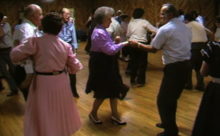Square Dance History Project
Square dancing has been an integral part of American social life for centuries. Traditional square dance was vital for generations of Americans, especially in rural communities; in the post-World War II era, modern square dance similarly enjoyed participants numbering in the millions.
Despite its popularity, the history of square dance has not been well documented. Scores of books explain specific figures and calls, but there are few current sources that offer a detailed discussion of the development of this form of American social dance.
Furthermore, there is an inherent limitation in using words to describe an activity that is rooted in music and motion; few available films illustrate the different styles of dancing that have developed over time and in different locales. The irony is that this very popularity helps explain the dearth of film documentation. "It was just something we all did," said one active dancer. "Why would we take movies of something so ordinary?"
The Square Dance History Project addresses this situation with two broad goals:
First, we will assemble a collection of moving images that exemplify different forms of square dance in North America, from New England to the southern Appalachians, Newfoundland to the Rocky Mountains including traditional and modern square dance. A national effort will scour archives, libraries, and personal collections to locate outstanding examples of each dance style, using home movies, newsreels, television shows, and documentary footage. We will also shoot additional videos to illustrate contemporary dances in different locales.
These moving images will be supplemented by photographs and audio files illustrating different styles over time and in different regions, drawing from our own collection and from material already posted in disparate locations on the Internet. We will include articles and other text to provide background information about music and dance styles, social context, specific callers and musicians, and local dance customs. Finally, we will provide videotaped interviews with recognized authorities on different styles of dance.
A second goal is to illustrate the historical antecedents behind today’s squares. We cannot include moving images of dancers from centuries past, but we will present dancers who demonstrate such early styles, along with reliable information about the development of those earlier forms of squares.
From dance callers seeking information about particular calls to social dance historians, from casual viewers to dance enthusiasts, the Square Dance History Project serves many users. The rich story of North American square dance finally has a home in the digital age.
